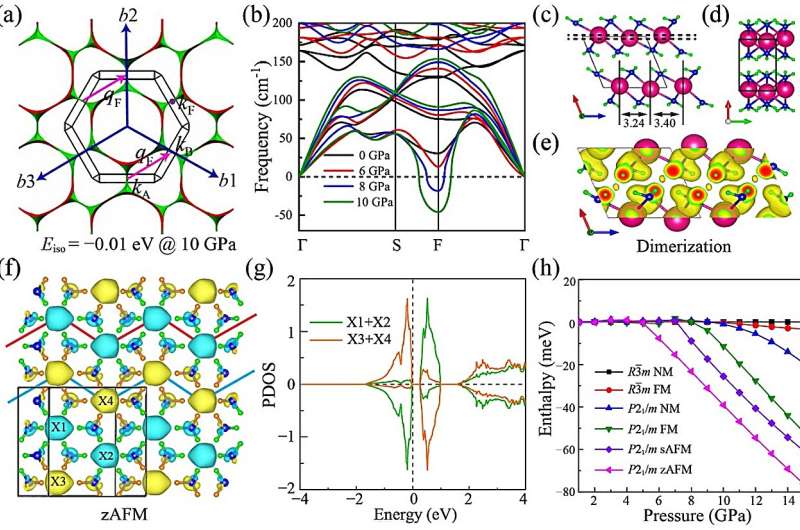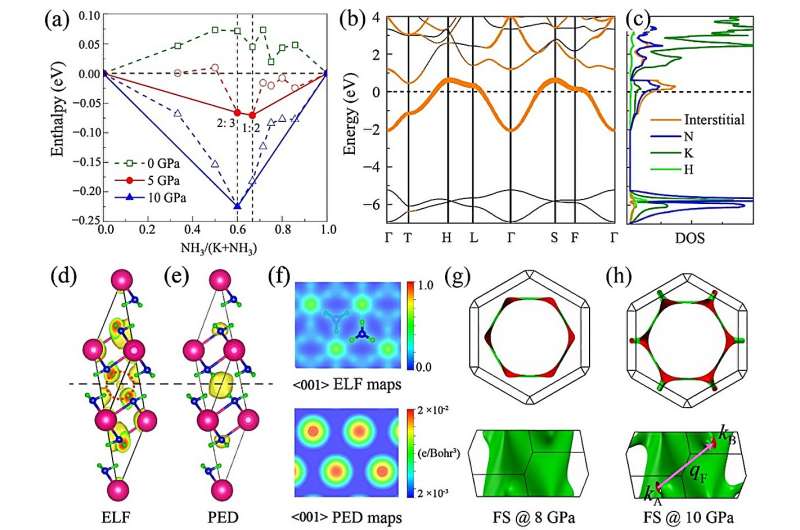Convex hull, projected band structure and partial density of states, with orange dots representing the contribution of interstitial sites. ELF and partial electron density (PED) of energy bands through the Fermi level, and corresponding cross-sectional images. Top and side views of the Fermi surface with saddle points.Image source: China Science Press
In a paper published in Chinese Science Bulletina team of Chinese scientists predicted a new electronic compound K(NH3)2, the interstitial electrons are distributed on the cage formed by six ammonia molecules, forming a quasi-two-dimensional triangular lattice. They found that the material undergoes a spin-Pells phase transition under moderate pressure.
The research was led by Professor Sun Jian from the National Laboratory of Solid State Microstructure and the Collaborative Innovation Center for Advanced Microstructure, School of Physics, Nanjing University. The team used the self-developed crystal structure prediction software MAGUS and first-principles calculations to determine the crystal structure of potassium ammonia compound under moderate pressure, which has long been considered an electronic compound at room temperature.
Electron-phonon interactions and electron-electron correlations represent two key aspects of condensed matter physics. In the model system of a half-filled spin 1/2 antiferromagnetic chain, the lattice dimer caused by the electron-nucleus interaction can be enhanced through the in-situ Coulomb repulsion, thus forming a spin Pells state. However, in two dimensions, real materials exhibiting this phenomenon have never been found.
Electron compounds, on the other hand, are materials in which unbound electrons occupy the crystal voids and exhibit anionic behavior (IAE). It is well known that the correlation between spin-polarized IAEs and their coupling to neighboring nuclei may give rise to more interesting quantum phenomena.
However, so far, there have been few studies exploring the interaction between relevant IAEs and phonons. One of the main reasons is the large number of atoms present in organic electronic compounds, where most antiferromagnetic IAEs occur.

Van Hove singularities, phonon softening, and lattice dimerization. Zigzag antiferromagnetism produced by gap electrons, density of states from IAE decomposition, and pressure-dependent enthalpy curves for twisted and untwisted structures with different magnetic orders.Image source: China Science Press
The research team determined that R-3m K(NH3)2 Thermodynamic stability is reached at around 2 GPa, using rhombohedral primitive cells, with ammonia molecules located on both sides of the potassium layer.
Some valence electrons are distributed in the interlayer cavity surrounded by six hydrogen atoms, forming interstitial anion electrons. The energy bands across the Fermi level are mainly attributed to these IAEs, which exist as isolated entities with bridging ammonia molecules.
The researchers also explored the effect of pressure on the properties of phonons and electrons. The van Hove singularity (VHS) is brought to the Fermi level at higher pressures, causing Pells-type instability and dimerized structures. These VHS also contribute to the formation of stepped densities of states, enhancing electronic correlations and inducing magnetic instabilities. The magnetic ground state was found to be zigzag antiferromagnetism, which can be described by the Heisenberg model of modulated nearest neighbor magnetic interactions.
More importantly, first-principles calculations show that magnetism and Peierls instability not only coexist, but also exhibit positive interactions, constituting an unprecedented spin-Peierls transition scenario in realistic 2D materials, especially involving IAE.
“It is very interesting to reveal such rich physical phenomena in real materials. The relevant interactions between IAEs and phonons can provide inspiration for the exploration of magnetic interactions, structural distortions and charge density waves,” Jian said.
More information:
Chi Ding et al., Quasi-two-dimensional spin Peierls transition through interstitial anion electrons in K(NH)3)2, Chinese Science Bulletin (2024). DOI: 10.1016/j.scib.2024.02.016
Provided by Science China Press
citation: Quasi-two-dimensional spin Peierls transition through interstitial anion electrons in K(NH) (2024, April 25) Retrieved April 26, 2024, from https://phys.org/news/2024-04 – quasi-2d-peierls-transition-gap.html
This document is protected by copyright. No part may be reproduced without written permission except in the interests of fair dealing for private study or research purposes. Content is for reference only.
#Quasitwodimensional #spin #Peierls #transition #interstitial #anion #electrons #KNH
Image Source : phys.org
